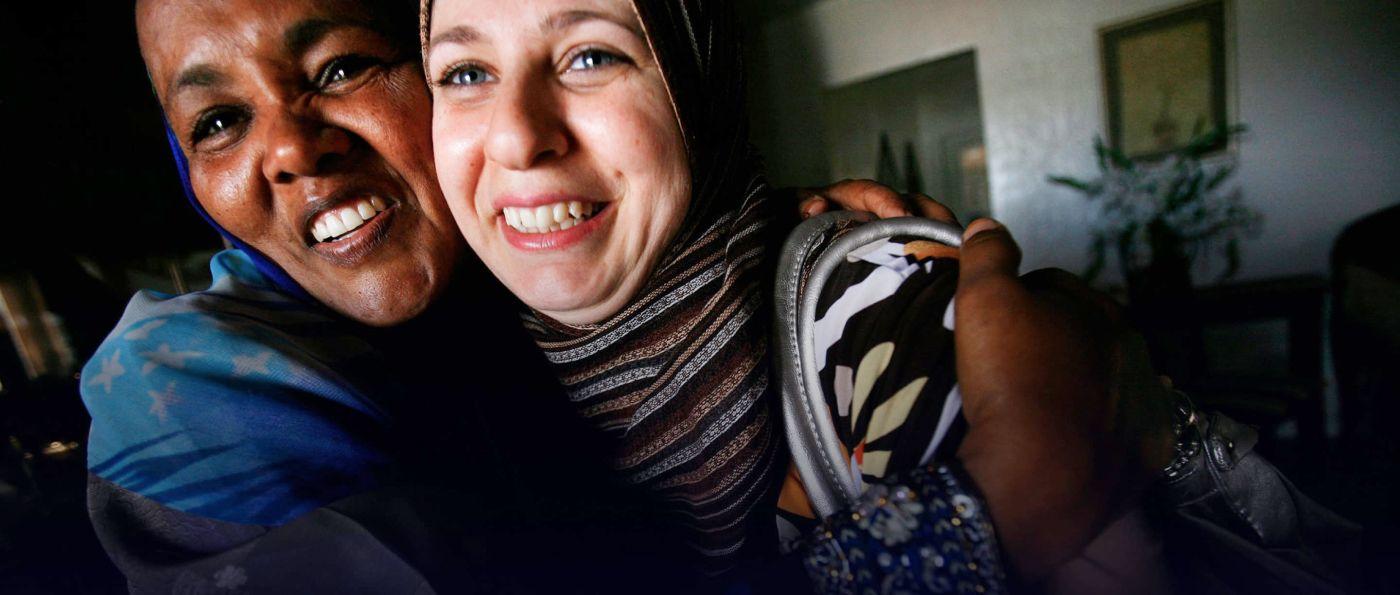

A Q&A with Stephanie Aubry, Ohio State University, Welcome Campus Network partner
College students are back on campus this fall, and among them are a growing number of refugee students. Partnerships like the Welcome Campus Network connect colleges, universities, and other stakeholders in higher education to actively welcome and support refugee students by providing resources like housing, scholarships, and pathways to continue their education. Stephanie Aubry, an assistant professor of practice in the Department of Spanish and Portuguese at Ohio State University, shared with Welcome.US how Ohio State is partnering with organizations to understand and support needs in their community, and also actively supporting the educational success of refugee students on campus.
When did Ohio State join the Welcome Campus Network, and why was this a priority for the university?
We joined just this year, and it was through World Learning that we learned about the Welcome Campus Network. We began a collaboration with a local refugee resettlement agency called CRIS, which stands for Community Refugee and Immigration Services, and this collaboration has been so impactful for us. [We have a few] goals: to create a more opening and welcoming campus for newcomers and also [focus on] community-based learning.
I teach in the Department of Spanish and Portuguese on our biggest campus, our Columbus campus of Ohio State. The Columbus campus has about 60,000 students. The regional campuses are much smaller; they might have about 2,000 students compared to our Columbus campus. And in the courses I teach specifically, many of the students were born in the U.S. Their parents were born in the U.S. Many of them are from the Midwest. And so, community-based learning is so important in our department for our majors and minors. In addition to teaching language skills, we also teach intercultural competence and global citizenship skills, which is really central to our mission.
The Welcome Campus network, again, is so impactful for us because it's connecting us to this nationwide network of experts all with different backgrounds so that we can gain new knowledge, begin new collaborations, begin new connections, really to benefit our students and to benefit our city.


In what ways does Ohio State contribute to and benefit from your participation in the Welcome Campus Network?
I teach a community-based learning course called Spanish in Ohio. I am also developing a general education course that is a community-based learning course, and that is really thanks to the support of World Learning. They're facilitating the creation of this new general education course, facilitating the community collaboration that we need to make this course a reality.
In terms of community-based learning, we are the ones that are benefiting—me and the students—from these collaborations. Columbus is such a diverse city with large newcomer communities. It's a wonderful secondary migration city compared to the East and the West coasts. We have a more affordable cost of living. It's a large city. So many businesses are headquartered in Columbus, so we have a lot of good jobs and high paying jobs. It's a great place to be. It's a great place to raise families with great public schools. But at Ohio State University, the students often are [in] an OSU bubble. They don't leave campus a lot. A lot of the students don't have their cars here in Columbus, and so they don't know what our city has to offer.
Through community-based learning, the students are able to leave campus and learn more about our city. They're able to be on the ground, collaborate with the community, and meet their neighbors. So in terms of teaching Spanish, if you're just teaching grammar in the classroom, that's not achieving the goal, right? If students are working in Latino communities, for example, they're practicing their Spanish language skills, but they're also developing intercultural competence.
Reciprocity for our community partners is something that always has to be top of mind in this type of course, in terms of Ohio State contributing, we're just getting started with this project, with the goal of creating a more welcoming campus. We're inviting the young people that are affiliated with CRIS to campus. Our undergraduate students are serving the role of just being a friend to these kids, letting them know, “Hey, this is our campus. This is the best place to get coffee, This is the best place to study.” And letting the students know you belong here. You're welcome here. This is where you can make a place for yourself, and this is a place that holds promise for your future. We're just getting started. But that's sort of our vision and our goal, and that's what we hope that we can achieve in the long term.


What are some of the barriers or greatest needs that refugee students face as they continue their education in the United States?
I was speaking to a colleague at OSU Newark about this. He said that typically in his classes, in a class of 30 students, maybe 26 students are people of color. Many of those students are newcomers. That regional campus is so diverse, and so it's different from our Columbus campus.
I was asking him about some of these barriers. One of them that he mentioned was language barriers. He said that the students that weren't born in the U.S., their English is really, really strong.
Having said that, when you're in a classroom and you have to speak out and participate in front of 30 people, you're taking a risk. So he thought that maybe language barriers could prevent the students from participating more actively in the classroom. I don't know what the solutions would be, but maybe certain cohorts of newcomer students working together.
Another barrier that we were talking about is cultural awareness training for employees. For faculty and staff, we're not always aware of religious holidays. For example, if we have students who are fasting, we don't want to plan a high-stakes exam for that day, or if it is programmed in the syllabus, the faculty need to be able to make an exception so that the student can reschedule the exam. I don't think it's fair for that responsibility to be on the shoulders of a young 20-year-old student. It can be daunting speaking to your professor, even if a professor is really open and accessible, it's still something that could be hard for a young person to do. I think it would be important for the university as a whole to take that responsibility off the students’ shoulders. If we had more cultural awareness training, I think that would help us to meet the students where they are.
The entire reason all of us are here is because of the students. So we always need to be student centered, which includes this cultural awareness training.
We do have the Center for Belonging and Social Change, which is a wonderful center that represents many different areas… If we could strengthen and grow cultural outreach on campus, that would provide more opportunities for newcomer students to have a place to belong, to have a place to call home, to empower the students, and to give them agency and a voice.


What is the greatest impact you’ve seen on your campus since welcoming refugee students? How has your campus community embraced welcoming?
The OSU Office of Outreach and Engagement provides amazing support for community-based learning and community-engaged scholarship. They provide seed grants, for example, and connections to research opportunities. Outreach and Engagement has provided strong support for the community-based learning course that I teach. We're so thankful to them. They are making reciprocity possible… It's a lot of work for the community partners to offer these opportunities for our students.It's a lot of time and planning. And we want to make sure that it's sustainable for the partners… The Office of Outreach and Engagement has been key. They have said that their upcoming seed grants will prioritize projects that focus on refugee resettlement.
I see the impact on the students and the course that I teach. The students and I talk a lot about asylum processes, because when you're thinking about Latino communities in Ohio, many who have just arrived in the U.S. are seeking asylum. We're learning the difference—what is the process for seeking asylum? What does refugee resettlement mean? What are the different countries that are represented in Columbus, and what's the history behind that? What happened before our neighbors came here to Columbus?
Really learning the details of immigration processes in the U.S., it gives students facts and evidence that they can use to think critically about migration in the U.S., about displacement, about movement around the world, and about what experiences are like once newcomers come to Ohio. That's really the impact that I see.
One of the things that we always think about in class is that the students, when they graduate, they're going to have influence. If they can have these community-based experiences and have that knowledge and global citizenship skills, hopefully when they enter their professions, they will have a positive influence on their colleagues as well.
Why would you encourage other colleges and universities to join the Welcome Campus Network?
It's so impactful for us because I'm just one person, and I'm trying to integrate curriculum related to refugee resettlement into this course. I'm trying to develop this course, grow the program, just as one person. I could be missing things.The Welcome Campus Network connects me to experts all over the U.S. What's so cool is each expert has their own background, their own expertise, their own knowledge. And so it puts us all into contact and a really welcoming space where you feel comfortable to speak up and to participate.
They share information that I can incorporate into the curriculum. I didn't know what readings to incorporate. Immediately, I was able to reach out and ask and get ideas and resources. Learning about new conferences across the country where we can get involved, the weekly information, the minutes, the regular updates, the regular connections that we have. It's just so important. I don't think that as an individual, you can do it without these nationwide collaborations.
More stories of welcome





